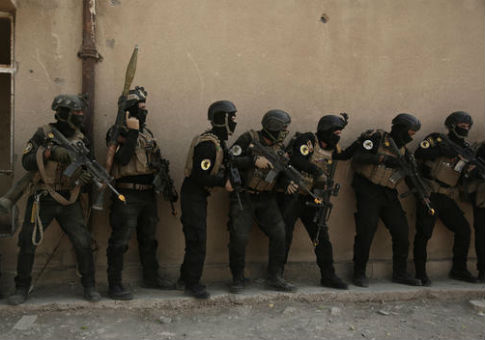It’s not quite D-Day, but an array of armies, militias, tribal fighters, and Western support troops are massing for their "longest day" in Mosul.
Islamic State terrorists have held the historic city of Mosul for nearly two and a half years, and they have dug networks of tunnels and filled moats with crude oil to lay waste to a city that has been called an open-air museum.
"Essentially, they've built a hell on Earth around themselves and they're going to be in that whenever the Iraqi security forces come in there and push them out," Col. John Dorrian, a spokesman for the allied coalition, said Friday via video link from Baghdad.
Terrorist troop strength has been worn down by relentless attacks from the Iraqi regular army and by coalition bombing in Mosul and surrounding Nineveh Province. The number of terrorists inside the city is somewhere between 3,000 and 5,000—half the estimated number from two months ago, according to military observers.
Nonetheless, ISIS-built defensive barriers are a force multiplier. The terrorist force has dug 18-foot-deep trenches around the city and filled these with oil and tar. Black smoke from burning moats has the potential to obscure targets pursued by fighter aircraft and drones. Tunnels have been dug connecting both banks of the Tigris River and also the northern end of the city to districts near the Qayara oil fields, allowing fighters, weapons, and supplies to be moved quickly. Some tunnels discovered after the fall of Fallujah were miles long.
"We expect them to use the same tactics they employed in Manbij (a border city in northern Syria) whereby they will use civilians as human shields. They will use many tunnels. Terrorists dressed as civilians will go into a house in one part of the city and appear in another part of the city with weapons," said Wladimir van Wilgenburg, a security expert affiliated with the Jamestown Foundation.
Iraqi counter-terrorism assault forces can expect houses, buildings, and streets studded with thousands of mines and improvised explosive devices, as well as car bombs and suicide bombers.
The jihadists have a unified command-and-control system whereas coalition commanders must coordinate fighters from multiple religions and language groups. These include 25,000 Iraqi regular soldiers, most of whom are Shia, approximately 6,000 Kurdish Peshmerga, who are majority Sunni, 4,500 support troops from the United States, and 3,500 NATO troops.
This force will be joined by 10,000 Sunni tribal fighters from Nineveh Province, 2,000 soldiers from the National Mobilization Force created by former governor Atheel Nujaifi, Assyrian Christians, and ethnic groups such as Yazidis and Shabaks—14,000 soldiers in all, according to Yonadam Kanna, a member of parliament and spokesman for the 500-soldier unit of Assyrian Christians.
Eager to join the Mosul campaign are 30,000 to 100,000 troops belonging to Shia militias, known as Popular Mobilization Forces, one-third of whom reportedly have been trained and equipped by Iran. The role these troops will play in Mosul is still uncertain.
"The Hashd al Shaabi will be needed to secure the perimeter around Mosul, because the Iraqi Army and Iraqi police don’t have enough troops," according to van Wilgenburg, using the Arabic name for the forces.
There are military wild cards as well. Armed groups willing to fight ISIS but not necessarily welcome by other members of the coalition. On Sinjar Mountain 80 miles west of Mosul are 3,000 to 5,000 Yazidi militia affiliated with the Marxist-leaning Kurdistan Workers’ Party (PKK) who would like to join the battle. NATO considers the party a terrorist group.
"The PKK based in Syria would like to play a role in Mosul, because it would like to open a corridor near Syria and does not want that corridor to be controlled by [Kurdish Regional Government President Massoud Barzani]," van Wilgenburg told a gathering of Iraqi experts at the Wilson Center on Monday.
Another wild card is the Turkish army, which continues to operate a military training base at Bashiqa less than 20 miles east of Mosul. Turkey currently has 1,000 ground forces spread across several locations and a "squadron of tanks" near Dahuk, Mr. Kanna said Wednesday.
Turkish President Recep Tayyip Erdogan said recently that Turkey would like to "work together" with the coalition to defeat ISIS. Iraqi Prime Minister Haider al-Abadi has repeatedly demanded that Turkish forces withdraw across the border.
Dorrian, the coalition spokesman, said Turkish troops in Iraq are not part of the coalition and that the Iraqi government will decide on the participants in Mosul's liberation.
"The Turkish forces are there to stop the PKK from having a role and possibly to strengthen the position of former governor Nujaifi," Mr. Kanaa said.
Finally, there is the question of whether a fifth column of resistance fighters inside Mosul could hasten ISIS’s defeat. Dozens of reports from Iraqi media claim such a force exists.
"[ISIS] has permitted some of its members to dress in ‘civilian garb,’ including wearing civilian clothes and cropping their beards, because of the rising number of assassination attempts against [ISIS] members in Mosul," according to a Wednesday story by Al Mawsleya TV reported by Daesh Daily.
Nujaifi has said that as many as 1,000 agents of his national mobilization forces are inside the city and could rise up.
"I can’t say there is an insurrection now, but I can say there is a resistance which could become an insurrection when ISIS become weaker, during the Mosul fight," Nujaifi said via text message on Wednesday. "There are thousands of people organizing themselves inside Mosul and waiting for the suitable time," he added.
Van Wilgenburg dismissed these reports as "propaganda."
